Day of Rural Women: A glimpse at the lives of Kenya’s rural women
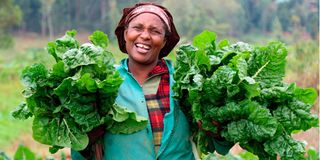
Mary Muthoni harvests spinach at her farm in Kiawaithanji village in Nyeri County on October 13, 2021. Today marks the International Day of Rural Women, a day that gives us a chance to celebrate rural women's accomplishments in their families and communities.
What you need to know:
- Gender and development indicators across the globe show that rural women fare worse than their male and urban counterparts.
- They disproportionately experience exclusion, poverty and the burden of climate change.
- This year’s theme of the International Day of Rural Women (October 15) is ‘Rural women confront the global cost-of-living crisis’.
The United Nations says achieving gender equality and empowering women is not only the right thing to do but also a critical ingredient in the fight against extreme poverty, hunger and malnutrition.
This coming Sunday, October 15,marks the International Day of Rural Woman, the first of which was observed in 2008.
It was created in 1995 by civil society organisations at the Fourth World Conference on Women in Beijing and declared an official United Nations Day in 2007 by the UN General Assembly.
The day gives us a chance to celebrate the accomplishments of rural women who play key roles in their families and communities yet are often disadvantaged, economically, socially and politically.
It recognises rural women’s critical role and contribution to enhancing agricultural and rural development, improving food security and eradicating rural poverty.
Today, we speak to Kenya’s rural women who share their joys and struggles living and working in mashinani.
Makueni women exporting woven baskets to Europe
Sofia Mwende hums a rendition of a gospel song while effortlessly twisting and turning strands of sisal fibre as a rope increasingly falls from her fingers in a sight to behold. Telling from the dexterity, one can hardly tell she is self-taught.
Mwende is among tens of women in the Kee area of Makueni County, who have made a fortune from handwoven sisal artefacts.
“When we are not making ropes, we are weaving baskets, hats, table and floor mats using sisal fibre. We also process and sell the sisal fibre itself locally,” she tells the Voice in an interview.
Mwende is the secretary at Kee Sisal Value Addition Group whose members weave and export baskets. The women are celebrating a decade of entrepreneurship when we meet them. They take turns in reflecting on their journey and roles in the cottage industry.
“As a child, I watched my parents make sisal fibres and ropes, which they sold to buy foodstuff and school necessities. Over the years, I learned and perfected the art of making sisal ropes and baskets through observation.
“In my adulthood, I went back to sisal fibre to relieve my husband of the burden of providing for our family. We came together and resolved to take the trade a notch higher by adding value to the products,” Mwende says.
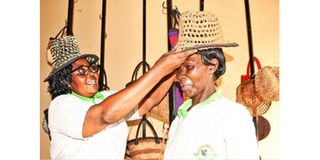
Sofia Mwende helps a member of Kee Sisal Value Addition Group put on a handwoven sisal hat in Kee township, Makueni County, on July 26, 2023. The women group make a living from weaving baskets, ropes, table and door mats using sisal fibre.
Her story mirrors that of her colleagues, many of whom picked their artistry from their parents.
Strangely, there are no sisal plantations in Kee. Members of Kee Sisal Value Addition Group individually grow sisal as border demarcation markers on their farms.
A farmer harvests the mature leaves for decortication, which is done at the group’s sisal decorticator machine stationed in Kee township. The resulting fibre is dried before it’s brushed using a heavy-duty fibre brusher. Save for the fibre meant for ropes, the rest is dyed to enhance its value.
Inside the sisal weavers’ workshop and curio shop in Kee township, visitors sample around 60 different designs of handwoven sisal baskets, hats, table mats and doormats.
At the centre of basketry entrepreneurship is creativity powered by information technology. Many of the baskets end up in overseas markets. Clients use social media to relay the design of products they want.
The weavers access and interpret the designs and upload them online for approval. They get to mass production of the artefacts after securing a thumbs up from the prospective customer.
“We prefer working from home so that we can also undertake other domestic chores. However, when serving orders with strict deadlines, we work from the workshop,” says Francisca Kimuyu, the chairperson of the association of weavers.
They outsource to weavers who are non-members when they land overwhelming orders. Mwende says a basket costs between Sh500 to Sh1,000 on average in local markets, depending on the size and design.
“A customer based in Poland buys standard sized baskets made using sisal fibre and dried banana stems. They are used for growing flowers. One of these baskets fetches Sh2,000. We sell around 150 such baskets a month,” says Kimuyu.
“Thanks to our enterprise, our children no longer walk around barefoot and with torn clothes. We are also able to offset school levies and afford nutritious meals for our families without exerting pressure on our husbands. We feel that we are playing a key role in keeping the environment clean through providing alternatives to plastic carrier bags,” she adds.
Members of the group are poised to tap the opportunities created by an ongoing campaign to promote commercial exploitation of indigenous knowledge.
Makueni is among the counties selected for the roll-out of the programme, which is spearheaded by the National Museums of Kenya.
At a recent exhibition organised by his administration, Makueni Governor Mutula Kilonzo Junior lauded Kee sisal weavers for keeping the sisal basketry heritage alive as he encouraged them to ride on the growing cultural significance of baskets as priced gifts and gift wrappers during weddings and other traditional ceremonies.
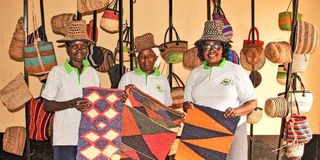
Kee Sisal Value Addition Group members at their workshop in Kee township, Makueni County, on July 26, 2023.
In addition to providing marketing opportunities, the devolved unit has provided the weavers with a decorticator while Kenya Climate Innovation Centre (KCIC) has offered them a heavy-duty brushing machine.
“These machines have made our work easy and significantly enhanced our production. KCIC has trained us how to extract natural dyes from the backs of particular indigenous plants. This is what we use to make our crafts attractive. We have also learned to make wooden looms, which we use to make floor mats and table placemats,” Mwende says.
They also attend workshops to build their capacities and showcase their work. “Telling from the orders we receive, the society is warming up to sisal products,” she adds.
The Kee sisal weaving enterprise, which started on a commercial scale in 2013, received a major boost three years later when the government banned single use plastic bags to address environmental pollution. The sustained campaign against plastics has translated into increased uptake of sisal baskets.
The women’s value proposition is environmental friendliness of their products, which last long compared to competition. To position themselves in the market, the weavers bank heavily on referrals. They also use exhibitions, which have so far proved to be the most promising marketing method. That is how in 2018 they met the customer based in Poland who has turned out to be the most promising.
To future-proof the enterprise, Kee weavers are mulling bringing on board young weavers. They also plan to set up a display shop in Wote town. They have acquired hybrid sisal seedlings for multiplication from a sisal estate that runs a sprawling sisal plantation near Kibwezi township.
I preach the gospel of the passion for fruit farming
Clad in a white coat and gumboots, she walks majestically as she checks whether the dangling fruit is ready for the market.
Judy Bitok is a purple passion farmer from Kamuri village in Kesses, where she farms four acres of the crop. She is among the growing number of farmers in the North Rift region, who have been growing the passion fruit.
Judy started the venture three years ago with about 400 plants. Today, she has about 4,000 plants. “I was motivated to venture into this crop after I realised it fetches better returns than other crops like maize do.”
Initially, she would buy the fruit and then sell it in the market, but decided to plant it herself for good returns. “The demand is still huge and we have never been able to meet it,” observes Judy.
A kilogramme of the passion fruit fetches between Sh90 and Sh140, depending on the season. The farmer harvests up to 800kg a week, which she sells in local and international markets, including Uganda, Dubai and European Union (EU) markets.
She explains that crop is a good crop for urban and rural women as they can make a tidy sum from its harvests.
“I preach the gospel about the passion for fruit farming. It is a fruit that fellow women can plant, make money, and meet their daily needs. They are core in a family and I want to encourage them to get into this business,” says Judy, also a high school teacher.
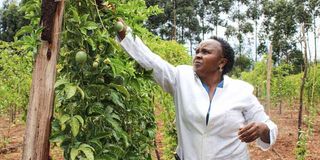
Mkulima Judy Bitok on her farm.
So, how does she balance between work and farm work? “When I am at work, I give my best and when I am on the farm, I also work hard.”
She has employed two workers on a permanent basis and five others on need-basis on her farm. After establishing a farm, she says it takes six months to start harvesting and from then, one harvests for over three years.
Judy, however, says she has to contend with a few challenges, including water scarcity, pests and diseases that attack the crop.
To mitigate some of these, she has constructed a water reservoir where she harvests water during the rainy season and waters the crops using the drip irrigation system.
“We don’t have water around here and, often, some flowers abort because of lack of water. We also have a challenge with organic fertiliser,” she explains.
Uasin Gishu County director in charge of Agriculture Reuben Seroney explains that passion fruit production stood at 3,840 tonnes last year.
The county generated Sh30 million from exports of the crop to European and Middle East markets such as Dubai, he says.
Currently, the crop is cultivated under 350 hectares and the county projects to attain more than 400 hectares by the end of the year.
“This is one of the high value crops that is really picking up. We want to encourage farmers to diversify and grow it because of higher returns compared to cereals,” adds the official.
He advises farmers to get certified seedlings from the nurseries that have been certified because the seedlings are clean and disease- free.
“This is one of the high value crops we are promoting as a county. We were able to reach farmers on crop husbandry and certification and to enable them to export their produce to the international markets,” says Mr Seroney.
He challenges passion fruit farmers to form groups to acquire processing facilities and engage in value addition to fetch better earnings.
“Farmers also need to embrace irrigated agriculture because during the dry seasons, they earn higher returns. During dry seasons, there is shortage of the produce in local and global markets,” adds the county official.
According to Judy, she has benefited from the training. She has learned how to handle the crop and proper use of agrochemicals to ensure minimum residual levels and that the crop is competitive in the local and international markets.
The women who rule fishing on Lake Victoria
Both men and women play distinct roles in the fishing industry, to ensure food security.
Men catch fish in water bodies, while women sell the delicacy at the market.
Traditionally, no woman would engage in fishing. They depended on what men caught. Men would also not sell fish in markets.
Instead, they own boats, which they use to catch fish. Owning a fishing vessel comes with pride as most men dictate all fishing activities.
In Homa Bay, fishermen who own most vessels in Lake Victoria engage in dictatorship while subduing women. Some allegedly force fishmongers who buy fish from them, to engage in illicit affairs just to supply them with fish, daily.
But women, who have had enough of the dictatorship, are beginning to engage in fish production.
Today, some of the boats in the lake are owned by women. They use the vessels to supply fish to other women who would have otherwise fallen prey to rogue fishermen.
Irene Omondi and Judith Adhiambo are among the women fishmongers in the county who own fishing boats.
For Ms Omondi, her involvement in activities in the lake has enabled her to climb the leadership ladder in beach management.
She is the Suba North Beach Management Unit (BMU) network chairperson, the only female in the position. She oversees activities on 42 beaches within the sub-county, which are all dominated by men.
“I used to oversee fishing activities on more beaches before Suba Central sub-county was hived off from Suba North,” Ms Omondi says.
Her journey in the industry started in 2000 when she was a regular fishmonger. Then, she would wait for men to go fishing in the lake and deliver the fish to her on the beach.
“I sold fish and later paid the suppliers. The men would sometimes fail to supply the delicacy when they find women they consider better buyers,” she says.
This is among factors that motivated her to own a boat. All she wanted was to have someone who would work for her and supply her with fish whether she needed it.
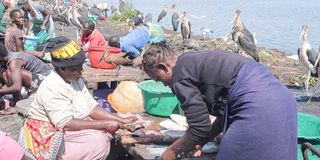
In 2006, the government introduced BMU, an organisation that acts as the eye of the state at the grassroots level.
In BMU regulations, officials are voted into office to look at activities of fishermen on their respective beaches. They are an equivalent of institutions that ensure correct fishing methods are practised.
At the BMU office, officials like the chairperson and deputy, secretary, and treasurer are elected every five years.
Ms Omondi was among boat owners who expressed their interest in one of the seats. She was first elected as the secretary of Olambwe BMU in Kasgunga, a position she held for five years. In the 2011 election, she retained the seat.
A few months later she stepped up the leadership ladder when she was appointed as the interim BMU chairperson of Olambwe Beach when the office holder stepped down.
“I took over the office officially in 2013 when an election was called. It was a confirmation that fishermen had confidence in me,” Ms Omondi says.
In the 2016 BMU election, she decided to move a step higher. She contested the position of the sub-county patrol chairperson, which she won by a landslide.
In all the elections, she competed against men. She served as the head of patrol until 2020. Her duties included ensuring fishermen use the right fishing gear.
Today, she owns four boats, which supply her with fish, some of which are given to other women to sell.
Ms Adhiambo also owns boats in the lake. She operates from Achich Beach in Homa Bay sub-county. Her story is, however, different. She was initially a crop farmer. But because of low yields, she shifted to fishing.
“I own four boats. The vessels are what sustains my family,” Ms Adhiambo says.
Her daily activities start at the house where she ensures all chores are done before she moves to the beach where she meets fishermen who spent the night in the lake.
“I help them to offload the fish before they are sold,” Ms Adhiambo says.
On a good day, she makes Sh50,000 from fish sales. The money is shared among fishermen operating the four vessels, with the owner of the boat getting the largest share.
Laikipia, Wajir women beading to change their lives
It is a Saturday morning and a group of women sit under an acacia tree in the parched plains of Laikipia County. They are busy making beaded ornaments as they look forward to the next market day.
The items include necklaces, earrings, bracelets, headgear, decorated belts, rungus (clubs), dresses and table mats, which they offer for sale during the Friday weekly market day at Doldol, the headquarters of Laikipia North.
Nashami Women Group is made up of 34 women from Kurum village, some living with disabilities, use needles and threads to join beads of varying colours on pieces of hides to make beautiful patterns on the items. In between the beadwork, they take breaks for lessons on the adverse effects of female genital mutilation (FGM) using dummies of the female reproductive organ.
“We use these dummies of female genitalia to illustrate the difference between a woman who is ‘whole’ and one who has been subjected to the painful cut. We also explain the consequences of this harmful cultural practice during birth. We then ask each member to go and teach their daughters about the dangers associated with FGM,” says Elizabeth Paraiton, a member of the group.
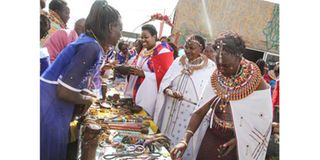
Members of Nashami Women Group and Yiaku Integrated Organisation from Laikipia North display some of their items on October 18, 2023. They are among 15 women’s groups who recently launched a cooperative to help market their products through the Ushanga Initiative.
Elizabeth, a former nominated MCA at the Laikipia County Assembly, says during their anti-FGM sessions, the women share and watch videos on their mobile phones on the cruelty of FGM. They are encouraged to make their daughters watch the videos at home and, at times, visit local schools to interact with girls.
The group is pegging elimination of prevalent harmful cultural practices such as FGM and child marriage to economic empowerment through diversification and creating markets for their beaded items.
“The main buyers for our items are outsiders since nearly every Maasai woman can make her own beaded ornaments. Accessing a reliable market remains a big challenge,” says Theresa Maskonte, the group chairperson.
However, the recent inclusion of Laikipia County in Ushanga Kenya, an initiative established in 2017 by the government through the State Department of Culture and Heritage, has given 15 women groups in Laikipia North an incentive to commercialise the traditional activity.
This initiative seeks to strengthen the business and production capacity for the pastoralist women and youth, as well as improve competitiveness in the local, regional and international market. Though Laikipia women groups have yet to sell their products through the Ushanga Kenya platform, they have redoubled their efforts on beadwork, meeting twice a week to increase their stock in readiness for emerging market opportunities.
In June, the Laikipia Ushanga Cooperative Society was launched to assist more than 200 women involved in beadwork on market linkages as they seek to diversify livelihoods.
Rosemary Nenini from Twala Cultural Manyatta says they have been involved in beadwork for a decade but rely on local communities to purchase their products, and occasional visitors at their ecotourism centre.
“We have been using proceeds from the beads to support the education of the girl child. With expanded markets and increased income, we shall be able to educate more girls and reduce cases of sexual and gender-based violence,” notes Rosemary.
Further North in Wajir County, we meet Barwaqo Weavers Society, a women’s group that specialises in beading and decorations.
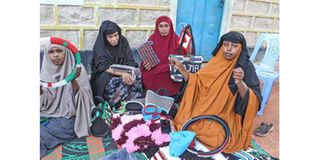
Members of the Barwaqo Weavers Association in Wajir display some of their artwork on September 6, 2023.
Safia Billow Mohamud, the secretary general, says they started the group in 2016 “to break boredom and over-dependence on their husbands”.
They also wanted to enjoy financial freedom. What started as a small venture is blossoming into a thriving women’s group.
It started with a membership of 20, with every member contributing Sh1,000 as capital.
“Some sponsors helped as source material,” Safia says.
The Wajir government also provided more material for the group, including the special thread and beads.
Besides the income-making venture, the women also teach each other life-changing skills.
“I knew nothing about beading but have learned a lot since I joined this group. Apart from working for the group, I can make my own decorations for my home and friends,” Najma Salat, a group member, says.
The Barwaqo Weavers Society has a dream of starting a company in Wajir town where they will do their beading and train other women in the same.
“We make door mats, table mats and baskets and curtains for homes,” Safia explains.
The group makes a killing from decorating car steering wheels for locals and organisations. To market the products, the group uses social media, including on Facebook and X (Twitter).
“You can easily come across our products on social media. The marketing is done by young members who are good at using digital devices. Our family members also help us post the products on social media,” she adds.
To obtain the skills and knowledge of their trade, the group organises regular training for new members. They also rely on YouTube to hone their skills.
“We learn other skills from YouTube and that is how we have managed to have unique products at our shops,” she says.
It costs one Sh3,000 to be recruited as a member.
“I joined the group in 2018 and I am at peace with my husband. Together, we contribute to our house expenses and all our children are in school,” Halima Ali, another member, says.
Besides the beading enterprise, Barwaqo group has tents and seats for hire, which is also a source of income.
“We also have a public address system that generates money for our group,” says Safia.
The County Department of Trade and Cooperatives has continued to support women in business through training and offering grants. Ms Katra Abdullahi, a cooperative officer in Wajir, says the county government supports women with table-banking skills.
They’ve forgotten us: Taita women bearing the brunt of water crisis
In Mzwanenyi village, Voi, Taita Taveta County, Jackline Mkamburi and her 14-year-old daughter have just returned from fetching water from Manolonyi village, seven kilometres away.
She says together with her children, they make at least two trips to the water kiosk every day. “We make one trip in the morning and another in the evening. The water is not enough, but we will balance it for the day,” she says.
The severe water scarcity in the area has caused immense disruption in locals’ lives, compelling them to embark on arduous journeys in pursuit of this vital and life-sustaining commodity.
What is supposed to be a simple daily chore has become a sheer struggle for survival. In most parts of the county, women and girls bear the brunt of this crisis, spending hours each day balancing jerrycans atop their heads as they embark on their search for water.
At Mzwanenyi, Jackline says, a 20-litre jerrycan costs Sh50 if delivered to the doorstep by boda boda vendors. Those who cannot afford to walk to a kiosk vendor in Manolonyi village who sells the jerrycan at Sh10.
“Sometimes the water is not there and we are forced to get water at Ghazi, which is like 10 kilometres away. Since it’s far, we buy from the boda boda vendors,” she adds.

A bare-feet woman carrying water pots to fetch drinking water.
There’s also an option of getting water from a nearby Mwabengu borehole. However, she says, it is salty and can only be used for cleaning dishes and bathing.
“The government has forgotten us. It’s like we don’t belong to this county. We have a tank through which the county government can provide water using bowsers but it has remained unused for more than a year now,” she says.
Drought in Taita Taveta County has caused a severe water shortage, leaving residents with no choice but to travel long distances in search of water.
In Paranga village, Wundanyi, Lydia Zae says women and girls are spending a significant amount of time trekking to fetch water.
Lydia, a girls’ rights activist in the area, says cases of early pregnancies are rife as perpetrators take advantage of the situation to prey on the minors.
“There’s an urgent need for sustainable solutions to protect girls from perpetrators who prey on them as they walk to fetch water,” she notes.
With water sources depleted and some rivers reduced to mere streams due to climate change, even residents living in highland areas of the county have been affected by the depletion of water sources.
In the Werugha area of Wundanyi sub-county, residents here are also grappling with the daunting challenge of trekking, battling with the hilly terrain and scorching sun in search of water.
The situation remains the same in Ngulu village, where women walk up to two hours to get water.
Cromwel Masaka, former chairperson of Mazizi water project, says some residents get water from the Mzazala, Mdundonyi or Mwandiria areas, which are about an hour away from Ngulu village.
He admits that residents spend most of the time ensuring their families and livestock have enough water supplies instead of going to their farms.
The water scarcity has catalysed a business opportunity for vendors, who capitalise on the desperation of the communities.
Families are forced to dig into their meagre income, sacrificing other critical needs to secure the basic commodity.
“We are hopeful that the government will find a lasting solution to the issue,” Cromwel says.
As water resources continue to dwindle, the county government says it has put measures in place to alleviate the crisis.
“This is a priority that the county government is planning to tackle. We are partnering with the national government and other organisations to ensure all residents can access clean water,” says Governor Andrew Mwadime.
By Pius Maundu, Stanley Kimuge, George Odiwuor, Mwangi Ndirangu, Manase Otsialo and Lucy Mkanyika ([email protected], [email protected], [email protected], [email protected], [email protected] and [email protected])



